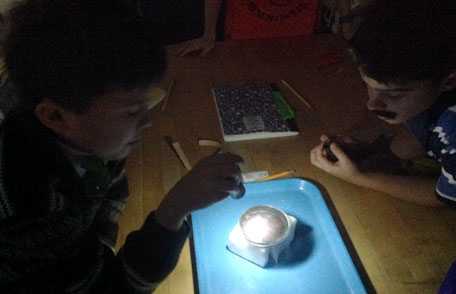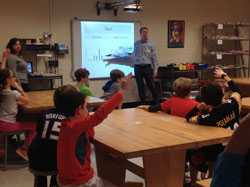Radon is Real! Educating Students about Radon Exposure

Radon is Real! ATSDR is educating students about the risk of radon exposure and the importance of testing.
In December 2015, Stephanie Foster of the Agency for Toxic Substances and Disease Registry (ATSDR’s) Geospatial Research, Analysis, and Services Program (GRASP) and Brian Tencza of the Environmental Medicine Branch, visited 3rd , 4th , and 5th grade classrooms to educate students about radon exposure.
Radon is an odorless, colorless, and tasteless radioactive gas, and its presence can only be determined by testing the indoor air of our homes, schools, and workplaces.
During the visit, over 400 students learned about radon and each student received a radon test kit to use at home. Furthermore, resources were sent home with students in the classrooms visited to encourage testing and radon reduction, if needed. Additionally, each class received a test kit to be used in rooms throughout the school.
An immediate outcome of this work was a sincere message of thanks from one homeowner who used the free test kit to discover that the indoor air in her newly built home had approximately twice the Environmental Protection Agency (EPA) action level for radon (4 pCi/L) . The homeowner shared that given her home was recently built she would not have tested because she believed the new home was protected against radon.
Equipped with the knowledge of the indoor radon concentrations the homeowner was able to contact a professional testing and mitigation company through review of resources available from EPA, Radon Program of the Georgia Department of Community Affairs, American Association of Radon Scientists and Technologist, and ATSDR websites.
The Importance of Radon Testing
Although the EPA encourages indoor air testing for radon and provides funding to some states in support of radon testing programs, the extent to which states conduct radon testing and monitoring programs differs across the nation. Raising awareness about radon exposure and the benefits of testing is critical in increasing the number of homeowners living in both old and new homes who know the level of indoor radon in their homes.
Supporting STEM Education with Radon Outreach
This partnership with the school also promotes science, technology, engineering, and mathematics (STEM) education. During the school visits, students were engaged in a variety of age-appropriate activities. For example, in addition to discussing radon the 5th grade students participated in a hands-on experiment demonstrating the presence of radioactive particles in the air. Using a petri dish, dark construction paper, felt, and rubbing alcohol the students were able to build a cloud chamber to see condensation trails produced from radioactive decay. This activity reinforced the idea that particles may exist in the air even though they cannot be seen with the naked eye.

ATSDR scientists educate students about public health careers, the toxin radon, and how to test their homes for the radioactive gas.
Radon Research in GRASP
The elementary school outreach is part of the Radon in Schools project, led by Stephanie Foster in GRASP at ATSDR. Through this work Stephanie hopes to raise awareness about radon exposure and encourage students and families to take action to protect their health. As the second leading cause of lung cancer after cigarette smoking, radon is associated with approximately 21,000 lung cancer deaths each year in the United States according to the EPA. The school outreach component of the Radon in Schools project is being completed in parallel with other geospatial research projects focused on understanding indoor radon potential. As a part of this complementary effort, GRASP scientists are using geographic information system (GIS) science and technology to examine the spatial relationship between residential radon test results and potential risk of radon in nearby schools. With hopes of expanding beyond Georgia, results from the spatial analysis can provide important information to assist school districts and public health partners to allocate limited resources to prioritize schools for routine radon testing and to promote construction of radon-resistant new schools.
Building Radon Collaborations
Looking to the future, Stephanie Foster states, “We are excited about the collaborative nature and impact of this work. In addition to working with ATSDR colleagues, we have initiated an internal radon working group bringing together scientists working on radon issues from CDC’s National Center for Environmental Health (NCEH’s) Environmental Public Health Tracking Network and the Radiation Studies Branch, and the National Center for Chronic Disease Prevention and Health Promotion’s Division of Cancer Prevention and Control’s Comprehensive Cancer Control Program.
Additionally, we have initiated discussions with the radon program of EPA Region 4 to develop collaborative programs between CDC/ATSDR, EPA, and the Department of Housing and Urban Development (HUD).” As the project progresses, hopefully a new generation will be aware of the impact of radon exposure and will be empowered to protect their future.
- Page last reviewed: August 21, 2017
- Page last updated: August 21, 2017
- Content source:
- Agency for Toxic Substances and Disease Registry
- Page maintained by: Office of the Associate Director for Communication, Digital Media Branch, Division of Public Affairs




 ShareCompartir
ShareCompartir